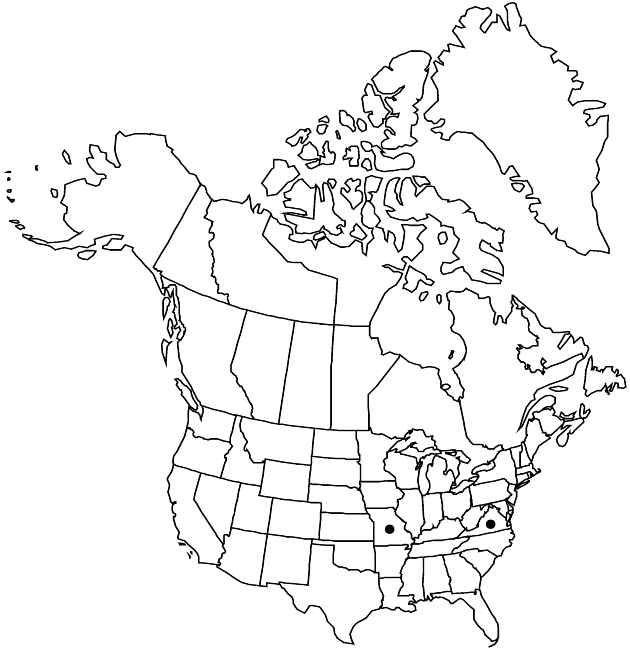Difference between revisions of "Helenium virginicum"
Claytonia 3: 13. 1936.
FNA>Volume Importer |
FNA>Volume Importer |
||
| Line 28: | Line 28: | ||
--><p><i>Helenium virginicum</i> is in the Center for Plant Conservation’s National Collection of Endangered Plants.</p> | --><p><i>Helenium virginicum</i> is in the Center for Plant Conservation’s National Collection of Endangered Plants.</p> | ||
|tables= | |tables= | ||
| − | |references= | + | |references={{Treatment/Reference |
| + | |id=simurda2000a | ||
| + | |text=Simurda, M. C., and J. S. Knox. 2000. ITS sequence evidence for the disjunct distribution between Virginia and Missouri of the narrow endemic Helenium virginicum. J. Torrey Bot. Soc. 127: 316–323. | ||
| + | }} | ||
}}<!-- | }}<!-- | ||
| Line 45: | Line 48: | ||
|elevation=300–500 m | |elevation=300–500 m | ||
|distribution=Mo.;Va. | |distribution=Mo.;Va. | ||
| − | |reference= | + | |reference=simurda2000a |
|publication title=Claytonia | |publication title=Claytonia | ||
|publication year=1936 | |publication year=1936 | ||
|special status= | |special status= | ||
| − | |source xml=https://jpend@bitbucket.org/aafc-mbb/fna-data-curation.git/src/ | + | |source xml=https://jpend@bitbucket.org/aafc-mbb/fna-data-curation.git/src/f50eec43f223ca0e34566be0b046453a0960e173/coarse_grained_fna_xml/V19-20-21/V21_1077.xml |
|tribe=Asteraceae tribe Heliantheae | |tribe=Asteraceae tribe Heliantheae | ||
|subtribe=Asteraceae (tribe Heliantheae) subtribe Gaillardiinae | |subtribe=Asteraceae (tribe Heliantheae) subtribe Gaillardiinae | ||
Revision as of 20:32, 16 December 2019
Perennials, 30–130 cm. Stems 1(–2), branched distally, strongly winged, glabrous or sparsely to moderately hairy proximally, glabrous or sparsely hairy distally. Leaves glabrous or sparsely to densely hairy; basal blades oblanceolate, weakly to strongly lobed; proximal and mid blades oblanceolate to lanceolate, usually entire, sometimes dentate; distal blades usually lanceolate, entire. Heads 2–25+ per plant, in paniculiform arrays. Peduncles 2–8 cm, sparsely to moderately hairy. Involucres globoid, 8–15 × 10–16 mm. Phyllaries (connate proximally) sparsely to moderately hairy. Ray florets 8–13, pistillate, fertile; corollas yellow, 10–15 × 4–10 mm. Disc florets 200–400+; corollas yellow proximally, yellow to yellow-brown distally, 2.5–3.5 mm, lobes 5. Cypselae 1.8–2.3 mm, moderately hairy; pappi of 5–6 entire, aristate scales 1.3–2 mm.
Phenology: Flowering Jul–Sep.
Habitat: Around ponds, lakes, and bogs, swampy meadows
Elevation: 300–500 m
Discussion
Of conservation concern.
M. C. Simurda and J. S. Knox (2000) presented ITS sequence data that placed a population of Helenium virginicum from the Ozark highlands of southern Missouri in a monophyletic group with six populations of H. virginicum from the Shenandoah Valley of Virginia. R. L. Rimer and J. W. Summers (Missouri Department of Conservation, pers. comm.) located 42 H. virginicum populations in six counties in the Ozark highlands of Missouri. G. A. Yatskievych (Missouri Botanical Garden, pers. comm. to editors) has stated, “. . . the existence of this taxon in Missouri is no longer a matter of a single odd population, but probably rather another case of a taxon with two disjunct centers following dissection of a range during the Pleistocene glaciation.”
Helenium virginicum is in the Center for Plant Conservation’s National Collection of Endangered Plants.
